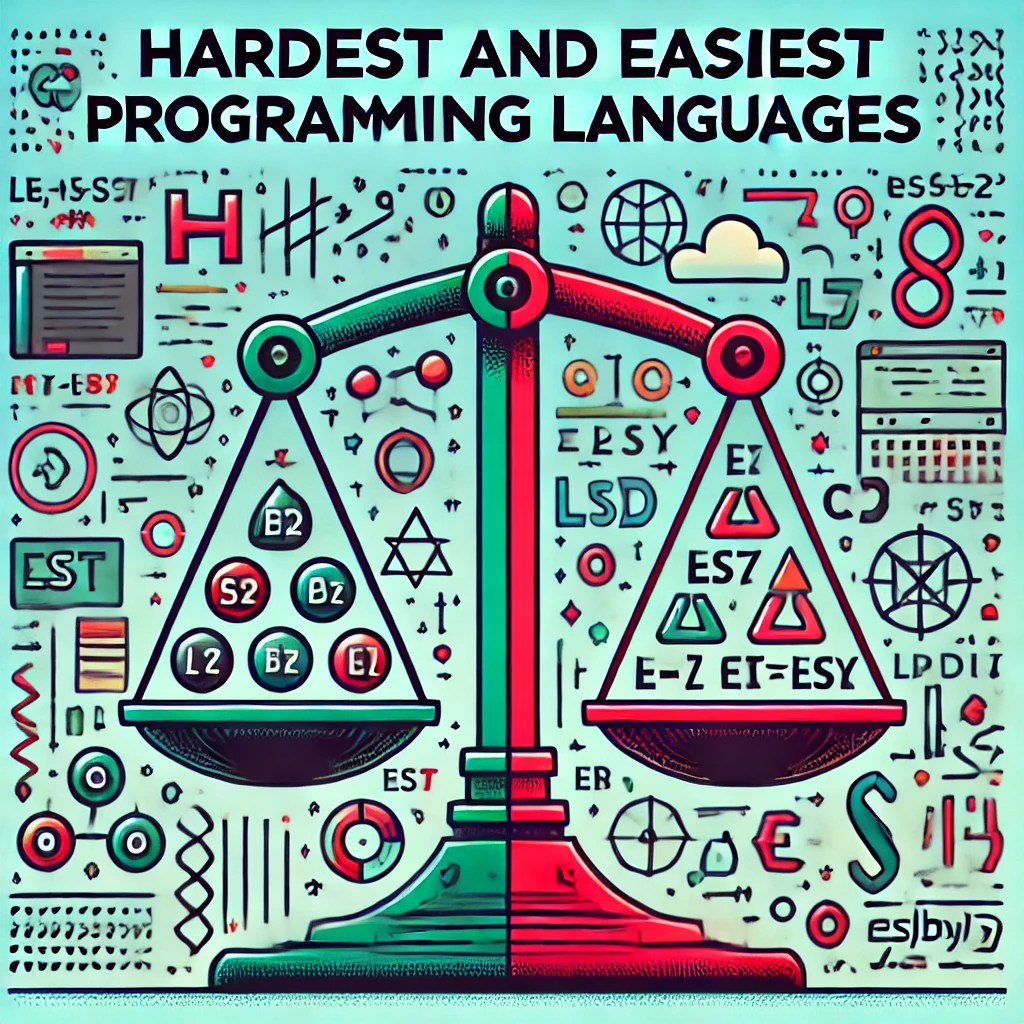In today’s world where the technology is evolving fast. Programming languages are considered as the backbones for the programming system, software development and web applications. Each programming language has its own specific set of rules, well-formed structure and pattern, that makes it easier to learn and use than the others. This article explains the hardest and easiest programming languages by examining the various factors on which their difficulty and simplicity is based.
Understanding Programming Language Difficulty
When we discuss about the difficulty level of the programming languages, several factors are kept in view:
- Syntax Complexity: Some programming languages have a complex syntax (structure of elements) that makes it harder for the beginners to learn.
- Abstraction Level: Low-level languages are generally harder to understand as compared to the high-level languages. This is because low-level languages require more detailed knowledge about the architecture of computer.
- Error Handling: Languages having lengthy error messages or strict system types are generally more challenging for the beginners.
- Community and Resources: A large number of learning resources as well as a strong community makes a language learning process easier for the beginners.
- Real-World Application: The availability of a language in industry also effects its difficulty level, because deep understanding is required for the practical use of programming languages.
The Easiest Programming Languages
Some of the easiest programming languages are mentioned below in the article along with the factors that make them easier.
Python
This is said to be the easiest programming language for the beginners. This is because Python uses a simple structure and arrangement of sentences that is almost similar to the natural language, making it easy to use.
Easiness Factors:
Readability: Python highlights readability and brief words that help the beginners to get a hold of concepts easily.
Large Community: A big community indicates large resources, libraries and tutorials that help to facilitate in learning.
Versatility: Python is a versatile language as it is used in various fields, that includes data science, artificial intelligence, web development, and automation. This makes python highly relevant in this field.
JavaScript
This is considered as the primary language for web development. This is because it allows the developers to make interactive and interesting web pages.
Easiness Factors:
Immediate Feedback: Due to its immediate response,developers see their changes in real-time, that encourages the beginners to have a hold of this language.
Simple Syntax: JavaScript has quirks but due to its basic structural arrangement, it is straightforward for the beginners.
Rich Ecosystems: With a large number of frameworks and libraries (like React and Vue.js), beginners can quickly build projects.
Ruby
Ruby is known for its elegant structure and arrangement of sentences (syntax). It majorly focuses the productivity and simplicity that makes it convincing for the beginners.
Easiness Factors:
Readable Code: Ruby’s structure is designed as natural that allows the beginners to write simple code that can be read in English.
Rails Framework: The Ruby on rails framework allows simple web application and development that serves as a solid foundation to help the new developers.
Strong Community: the Ruby community is supportive and welcoming that brighten ups the learning experience.
Scratch
Scratch is a visual programming language whose primary aim is for the children and beginners. This allows the users to create interactive stories and games.
Easiness Factors:
Visual Interface: Scratch eliminates syntax errors by using blocks instead of text. This method allows the users to focus on the creativity as well as the logic.
Engaging Learning Environment: Scratch has a game-like environment that makes the programming fun, which maintains the user’s interests.
Educational Focus: Scratch is originally designed for educational purposes. This makes it a popular choice for teaching programming important.
The Hardest Programming Languages
These include:
C + +
C+ + is a powerful and high-performance language that is often used in the systems programing as well as game development and applications that require speed.
Hardness Factors:
Complex Syntax: C+ + syntax is one of the most complex syntaxes than many other high-level languages. This type of syntax includes large amount of pointer usage and manual memory management.
Error Handlings: This language comprises less understanding of error handling. Due to this reason, it can be discouraging for the beginners.
Abstraction Levels: C+ + provides both the low and high-level features. This function leads to a high learning curve as developers should know and understand both of the features.
Haskell
Haskell is a purely functional programming language that is known for its strong stable typing and lazy judgement.
Hardness Factors
Functional Paradigm: The functional programming paradigm can be challenging for those familiar to the important programming styles.
Abstract Concepts: Haskell relies on abstract concepts like monads. This can confuse the beginners who lack experience with functional programming.
Limited Resources: The Haskell’s community and resources are not as large compared to the more popular languages. This makes it harder to find help.
Assembly Language
This is a low-level programming language that is closely related to the machine code.
Hardness Factors:
Hardware Specificity: Each type of CPU architecture has its own assembly language. This requires a deep understanding of hardware.
Complexity: Writing in assembly language involves careful attention to the details and a thorough understanding of how computers work at a low level.
Lack of Abstraction: Assembly provides minimal abstraction. This means that programmers must manage every aspect of memory and processing on their own.
Prolog
Prolog is a logical programming language that is associated with artificial intelligence and computer’s language.
Hardness Factors:
Different Paradigm: Prolog is based on formal logic. Due to which it can be a significant shift for those who are used to important or object-oriented languages.
Non-Linear Execution: The execution model of Prolog is non-linear. This makes it challenging for the new programmers to predict how code will run.
Limited Applicability: Prolog is not widely used as other programming languages. This makes it less motivating to learn this for the practical usage.
Conclusion
Choosing a programming language often depends on your individual goals, background, and the specific projects you want to pursue. All the above-mentioned languages either hard or easy represent challenges for the beginners that can significantly benefit those who are trying hard to understand the difficult concepts of programming.
In the landscape of software development, it’s essential to recognize that difficulty is subjective. What one programmer finds easy; another may find challenging. Ultimately, the best approach is to start with a language that aligns with personal interests and career objectives while remaining open to exploring more complex languages as skills develop. Emphasizing practice, community engagement, and continuous learning will make the journey through the varying world of programming languages an improving experience.
Frequently Asked Questions (FAQs)
What are the easiest programming languages for the beginners?
The easiest programming languages include:
- Python: Known for its simple syntax and readability, Python is ideal for beginners.
- JavaScript: As the backbone of web development, JavaScript allows immediate feedback and is relatively easy to learn.
- Ruby: With an elegant syntax, Ruby is designed for simplicity and productivity.
- Scratch: A visual programming language perfect for kids, Scratch uses blocks to teach programming logic without syntax errors.
How can I choose the right programming language to learn first?
- Consider your goals: If you’re interested in web development, JavaScript may be the best choice. For data science, Python is a strong contender.
- Assess your background: If you’re completely new, starting with an easier language like Python can build your confidence.
- Look for resources: Choose a language with ample tutorials, courses, and a supportive community.
Can I transition from an easy language to a hard one?
Yes Absolutely! Many programmers start with easier languages and gradually tackle more complex ones. The foundational skills you develop will help in understanding harder languages.
Found this helpful? Don’t miss out on our other great articles!



